LINCOLN MKZ HYBRID 2019 Owners Manual
Manufacturer: LINCOLN, Model Year: 2019, Model line: MKZ HYBRID, Model: LINCOLN MKZ HYBRID 2019Pages: 575, PDF Size: 4.77 MB
Page 171 of 575
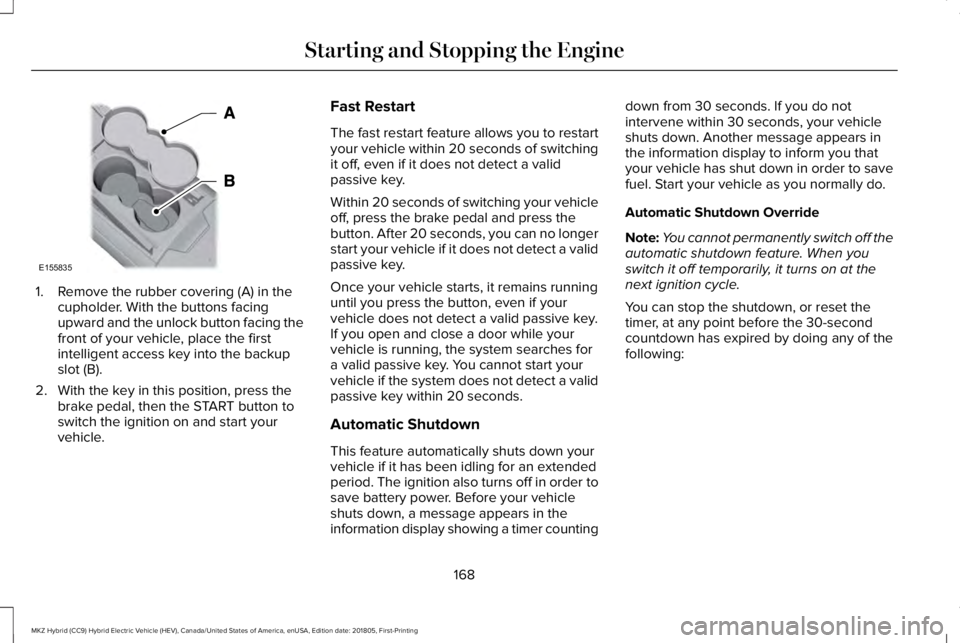
1. Remove the rubber covering (A) in thecupholder. With the buttons facingupward and the unlock button facing thefront of your vehicle, place the firstintelligent access key into the backupslot (B).
2. With the key in this position, press thebrake pedal, then the START button toswitch the ignition on and start yourvehicle.
Fast Restart
The fast restart feature allows you to restartyour vehicle within 20 seconds of switchingit off, even if it does not detect a validpassive key.
Within 20 seconds of switching your vehicleoff, press the brake pedal and press thebutton. After 20 seconds, you can no longerstart your vehicle if it does not detect a validpassive key.
Once your vehicle starts, it remains runninguntil you press the button, even if yourvehicle does not detect a valid passive key.If you open and close a door while yourvehicle is running, the system searches fora valid passive key. You cannot start yourvehicle if the system does not detect a validpassive key within 20 seconds.
Automatic Shutdown
This feature automatically shuts down yourvehicle if it has been idling for an extendedperiod. The ignition also turns off in order tosave battery power. Before your vehicleshuts down, a message appears in theinformation display showing a timer counting
down from 30 seconds. If you do notintervene within 30 seconds, your vehicleshuts down. Another message appears inthe information display to inform you thatyour vehicle has shut down in order to savefuel. Start your vehicle as you normally do.
Automatic Shutdown Override
Note:You cannot permanently switch off theautomatic shutdown feature. When youswitch it off temporarily, it turns on at thenext ignition cycle.
You can stop the shutdown, or reset thetimer, at any point before the 30-secondcountdown has expired by doing any of thefollowing:
168
MKZ Hybrid (CC9) Hybrid Electric Vehicle (HEV), Canada/United States of America, enUSA, Edition date: 201805, First-Printing
Starting and Stopping the EngineE155835
Page 172 of 575
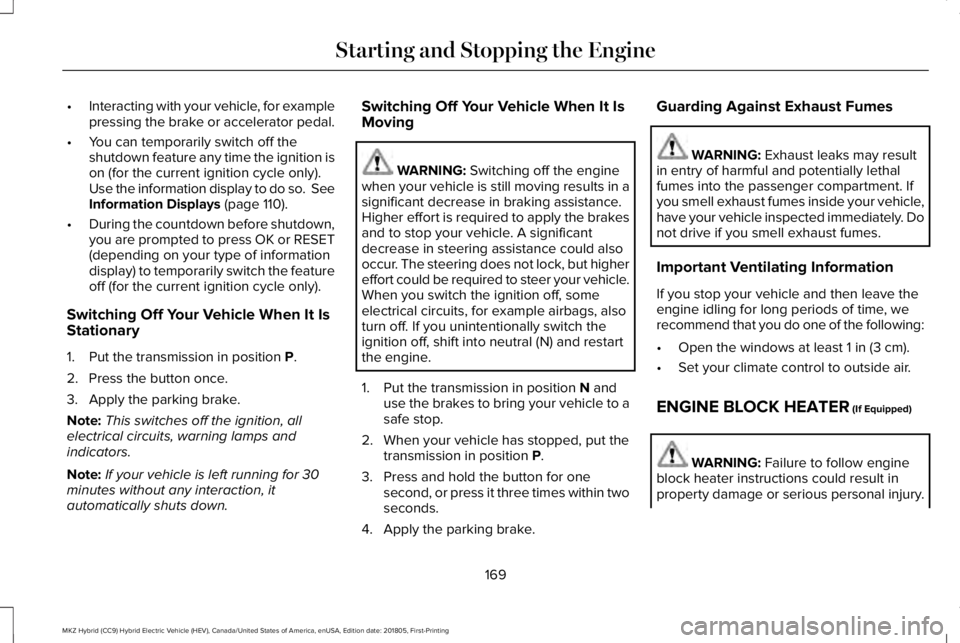
•Interacting with your vehicle, for examplepressing the brake or accelerator pedal.
•You can temporarily switch off theshutdown feature any time the ignition ison (for the current ignition cycle only).Use the information display to do so. SeeInformation Displays (page 110).
•During the countdown before shutdown,you are prompted to press OK or RESET(depending on your type of informationdisplay) to temporarily switch the featureoff (for the current ignition cycle only).
Switching Off Your Vehicle When It IsStationary
1. Put the transmission in position P.
2. Press the button once.
3. Apply the parking brake.
Note:This switches off the ignition, allelectrical circuits, warning lamps andindicators.
Note:If your vehicle is left running for 30minutes without any interaction, itautomatically shuts down.
Switching Off Your Vehicle When It IsMoving
WARNING: Switching off the enginewhen your vehicle is still moving results in asignificant decrease in braking assistance.Higher effort is required to apply the brakesand to stop your vehicle. A significantdecrease in steering assistance could alsooccur. The steering does not lock, but highereffort could be required to steer your vehicle.When you switch the ignition off, someelectrical circuits, for example airbags, alsoturn off. If you unintentionally switch theignition off, shift into neutral (N) and restartthe engine.
1. Put the transmission in position N anduse the brakes to bring your vehicle to asafe stop.
2. When your vehicle has stopped, put thetransmission in position P.
3. Press and hold the button for onesecond, or press it three times within twoseconds.
4. Apply the parking brake.
Guarding Against Exhaust Fumes
WARNING: Exhaust leaks may resultin entry of harmful and potentially lethalfumes into the passenger compartment. Ifyou smell exhaust fumes inside your vehicle,have your vehicle inspected immediately. Donot drive if you smell exhaust fumes.
Important Ventilating Information
If you stop your vehicle and then leave theengine idling for long periods of time, werecommend that you do one of the following:
•Open the windows at least 1 in (3 cm).
•Set your climate control to outside air.
ENGINE BLOCK HEATER (If Equipped)
WARNING: Failure to follow engineblock heater instructions could result inproperty damage or serious personal injury.
169
MKZ Hybrid (CC9) Hybrid Electric Vehicle (HEV), Canada/United States of America, enUSA, Edition date: 201805, First-Printing
Starting and Stopping the Engine
Page 173 of 575
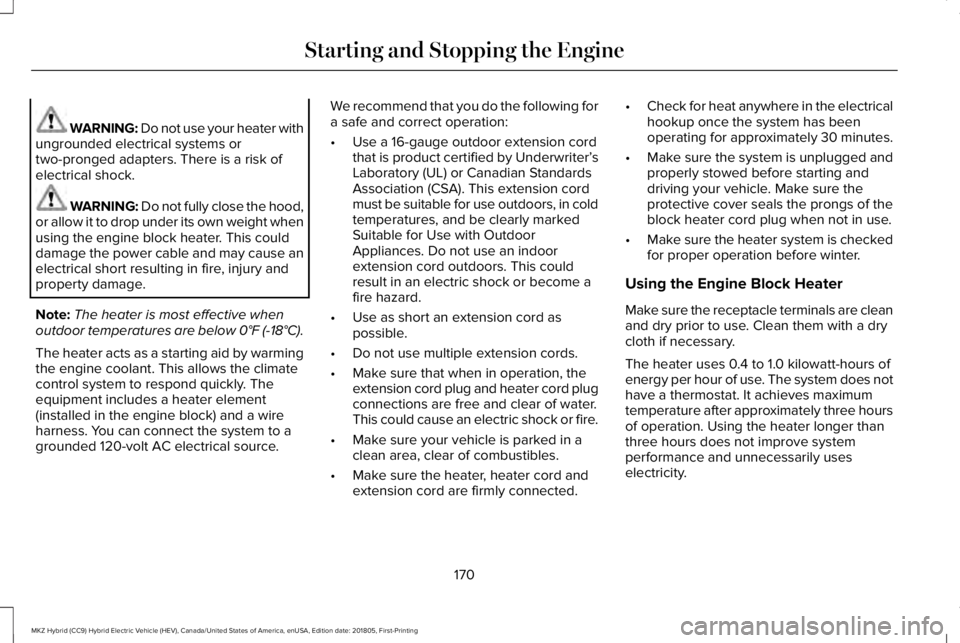
WARNING: Do not use your heater withungrounded electrical systems ortwo-pronged adapters. There is a risk ofelectrical shock.
WARNING: Do not fully close the hood,or allow it to drop under its own weight whenusing the engine block heater. This coulddamage the power cable and may cause anelectrical short resulting in fire, injury andproperty damage.
Note:The heater is most effective whenoutdoor temperatures are below 0°F (-18°C).
The heater acts as a starting aid by warmingthe engine coolant. This allows the climatecontrol system to respond quickly. Theequipment includes a heater element(installed in the engine block) and a wireharness. You can connect the system to agrounded 120-volt AC electrical source.
We recommend that you do the following fora safe and correct operation:
•Use a 16-gauge outdoor extension cordthat is product certified by Underwriter’sLaboratory (UL) or Canadian StandardsAssociation (CSA). This extension cordmust be suitable for use outdoors, in coldtemperatures, and be clearly markedSuitable for Use with OutdoorAppliances. Do not use an indoorextension cord outdoors. This couldresult in an electric shock or become afire hazard.
•Use as short an extension cord aspossible.
•Do not use multiple extension cords.
•Make sure that when in operation, theextension cord plug and heater cord plugconnections are free and clear of water.This could cause an electric shock or fire.
•Make sure your vehicle is parked in aclean area, clear of combustibles.
•Make sure the heater, heater cord andextension cord are firmly connected.
•Check for heat anywhere in the electricalhookup once the system has beenoperating for approximately 30 minutes.
•Make sure the system is unplugged andproperly stowed before starting anddriving your vehicle. Make sure theprotective cover seals the prongs of theblock heater cord plug when not in use.
•Make sure the heater system is checkedfor proper operation before winter.
Using the Engine Block Heater
Make sure the receptacle terminals are cleanand dry prior to use. Clean them with a drycloth if necessary.
The heater uses 0.4 to 1.0 kilowatt-hours ofenergy per hour of use. The system does nothave a thermostat. It achieves maximumtemperature after approximately three hoursof operation. Using the heater longer thanthree hours does not improve systemperformance and unnecessarily useselectricity.
170
MKZ Hybrid (CC9) Hybrid Electric Vehicle (HEV), Canada/United States of America, enUSA, Edition date: 201805, First-Printing
Starting and Stopping the Engine
Page 174 of 575
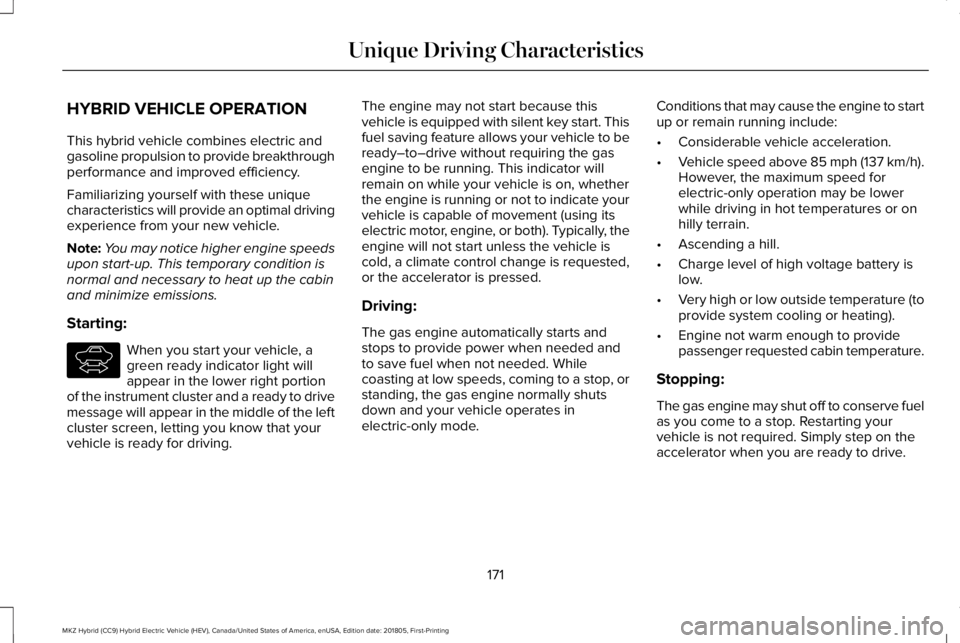
HYBRID VEHICLE OPERATION
This hybrid vehicle combines electric andgasoline propulsion to provide breakthroughperformance and improved efficiency.
Familiarizing yourself with these uniquecharacteristics will provide an optimal drivingexperience from your new vehicle.
Note:You may notice higher engine speedsupon start-up. This temporary condition isnormal and necessary to heat up the cabinand minimize emissions.
Starting:
When you start your vehicle, agreen ready indicator light willappear in the lower right portionof the instrument cluster and a ready to drivemessage will appear in the middle of the leftcluster screen, letting you know that yourvehicle is ready for driving.
The engine may not start because thisvehicle is equipped with silent key start. Thisfuel saving feature allows your vehicle to beready–to–drive without requiring the gasengine to be running. This indicator willremain on while your vehicle is on, whetherthe engine is running or not to indicate yourvehicle is capable of movement (using itselectric motor, engine, or both). Typically, theengine will not start unless the vehicle iscold, a climate control change is requested,or the accelerator is pressed.
Driving:
The gas engine automatically starts andstops to provide power when needed andto save fuel when not needed. Whilecoasting at low speeds, coming to a stop, orstanding, the gas engine normally shutsdown and your vehicle operates inelectric-only mode.
Conditions that may cause the engine to startup or remain running include:
•Considerable vehicle acceleration.
•Vehicle speed above 85 mph (137 km/h).However, the maximum speed forelectric-only operation may be lowerwhile driving in hot temperatures or onhilly terrain.
•Ascending a hill.
•Charge level of high voltage battery islow.
•Very high or low outside temperature (toprovide system cooling or heating).
•Engine not warm enough to providepassenger requested cabin temperature.
Stopping:
The gas engine may shut off to conserve fuelas you come to a stop. Restarting yourvehicle is not required. Simply step on theaccelerator when you are ready to drive.
171
MKZ Hybrid (CC9) Hybrid Electric Vehicle (HEV), Canada/United States of America, enUSA, Edition date: 201805, First-Printing
Unique Driving CharacteristicsE144692
Page 175 of 575
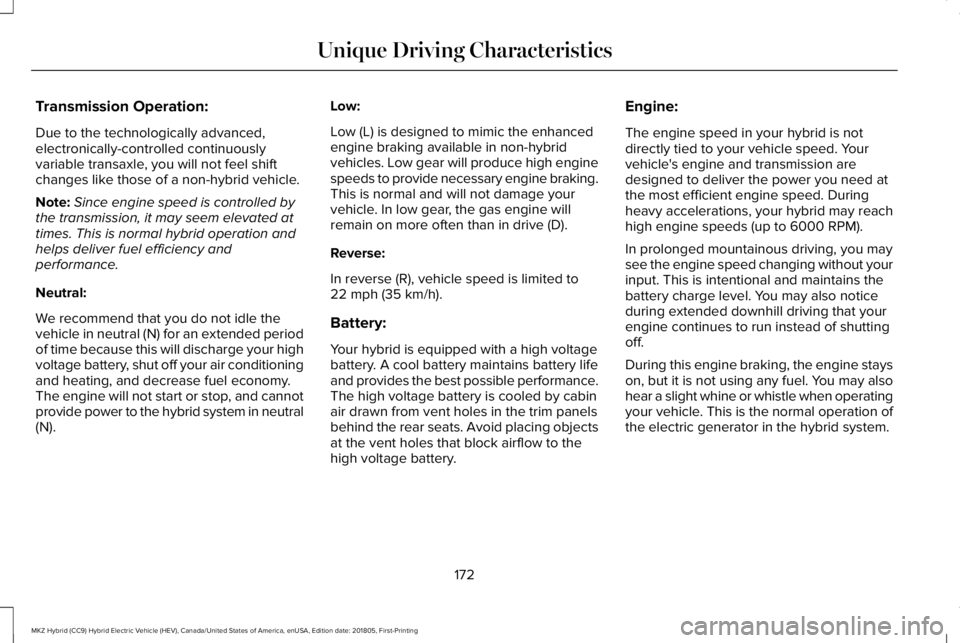
Transmission Operation:
Due to the technologically advanced,electronically-controlled continuouslyvariable transaxle, you will not feel shiftchanges like those of a non-hybrid vehicle.
Note:Since engine speed is controlled bythe transmission, it may seem elevated attimes. This is normal hybrid operation andhelps deliver fuel efficiency andperformance.
Neutral:
We recommend that you do not idle thevehicle in neutral (N) for an extended periodof time because this will discharge your highvoltage battery, shut off your air conditioningand heating, and decrease fuel economy.The engine will not start or stop, and cannotprovide power to the hybrid system in neutral(N).
Low:
Low (L) is designed to mimic the enhancedengine braking available in non-hybridvehicles. Low gear will produce high enginespeeds to provide necessary engine braking.This is normal and will not damage yourvehicle. In low gear, the gas engine willremain on more often than in drive (D).
Reverse:
In reverse (R), vehicle speed is limited to22 mph (35 km/h).
Battery:
Your hybrid is equipped with a high voltagebattery. A cool battery maintains battery lifeand provides the best possible performance.The high voltage battery is cooled by cabinair drawn from vent holes in the trim panelsbehind the rear seats. Avoid placing objectsat the vent holes that block airflow to thehigh voltage battery.
Engine:
The engine speed in your hybrid is notdirectly tied to your vehicle speed. Yourvehicle's engine and transmission aredesigned to deliver the power you need atthe most efficient engine speed. Duringheavy accelerations, your hybrid may reachhigh engine speeds (up to 6000 RPM).
In prolonged mountainous driving, you maysee the engine speed changing without yourinput. This is intentional and maintains thebattery charge level. You may also noticeduring extended downhill driving that yourengine continues to run instead of shuttingoff.
During this engine braking, the engine stayson, but it is not using any fuel. You may alsohear a slight whine or whistle when operatingyour vehicle. This is the normal operation ofthe electric generator in the hybrid system.
172
MKZ Hybrid (CC9) Hybrid Electric Vehicle (HEV), Canada/United States of America, enUSA, Edition date: 201805, First-Printing
Unique Driving Characteristics
Page 176 of 575
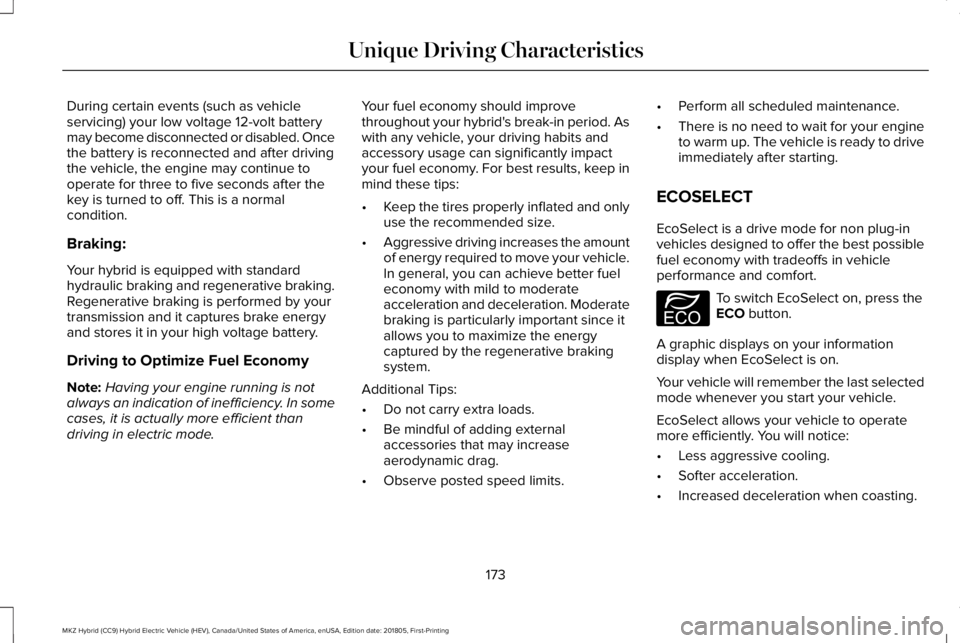
During certain events (such as vehicleservicing) your low voltage 12-volt batterymay become disconnected or disabled. Oncethe battery is reconnected and after drivingthe vehicle, the engine may continue tooperate for three to five seconds after thekey is turned to off. This is a normalcondition.
Braking:
Your hybrid is equipped with standardhydraulic braking and regenerative braking.Regenerative braking is performed by yourtransmission and it captures brake energyand stores it in your high voltage battery.
Driving to Optimize Fuel Economy
Note:Having your engine running is notalways an indication of inefficiency. In somecases, it is actually more efficient thandriving in electric mode.
Your fuel economy should improvethroughout your hybrid's break-in period. Aswith any vehicle, your driving habits andaccessory usage can significantly impactyour fuel economy. For best results, keep inmind these tips:
•Keep the tires properly inflated and onlyuse the recommended size.
•Aggressive driving increases the amountof energy required to move your vehicle.In general, you can achieve better fueleconomy with mild to moderateacceleration and deceleration. Moderatebraking is particularly important since itallows you to maximize the energycaptured by the regenerative brakingsystem.
Additional Tips:
•Do not carry extra loads.
•Be mindful of adding externalaccessories that may increaseaerodynamic drag.
•Observe posted speed limits.
•Perform all scheduled maintenance.
•There is no need to wait for your engineto warm up. The vehicle is ready to driveimmediately after starting.
ECOSELECT
EcoSelect is a drive mode for non plug-invehicles designed to offer the best possiblefuel economy with tradeoffs in vehicleperformance and comfort.
To switch EcoSelect on, press theECO button.
A graphic displays on your informationdisplay when EcoSelect is on.
Your vehicle will remember the last selectedmode whenever you start your vehicle.
EcoSelect allows your vehicle to operatemore efficiently. You will notice:
•Less aggressive cooling.
•Softer acceleration.
•Increased deceleration when coasting.
173
MKZ Hybrid (CC9) Hybrid Electric Vehicle (HEV), Canada/United States of America, enUSA, Edition date: 201805, First-Printing
Unique Driving CharacteristicsE198654
Page 177 of 575
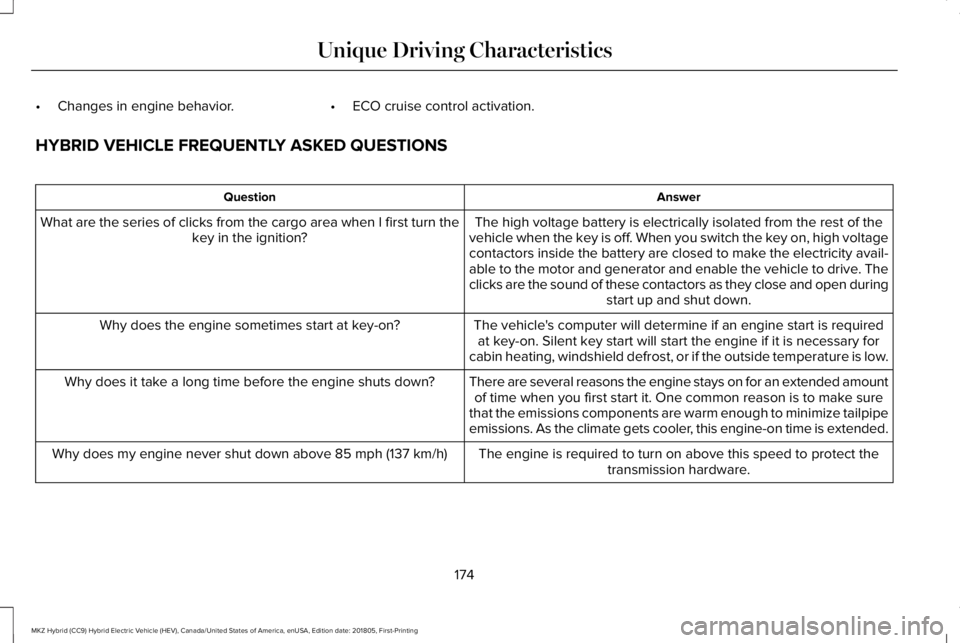
•Changes in engine behavior.•ECO cruise control activation.
HYBRID VEHICLE FREQUENTLY ASKED QUESTIONS
AnswerQuestion
The high voltage battery is electrically isolated from the rest of thevehicle when the key is off. When you switch the key on, high voltagecontactors inside the battery are closed to make the electricity avail-able to the motor and generator and enable the vehicle to drive. Theclicks are the sound of these contactors as they close and open duringstart up and shut down.
What are the series of clicks from the cargo area when I first turn thekey in the ignition?
The vehicle's computer will determine if an engine start is requiredat key-on. Silent key start will start the engine if it is necessary forcabin heating, windshield defrost, or if the outside temperature is low.
Why does the engine sometimes start at key-on?
There are several reasons the engine stays on for an extended amountof time when you first start it. One common reason is to make surethat the emissions components are warm enough to minimize tailpipeemissions. As the climate gets cooler, this engine-on time is extended.
Why does it take a long time before the engine shuts down?
The engine is required to turn on above this speed to protect thetransmission hardware.Why does my engine never shut down above 85 mph (137 km/h)
174
MKZ Hybrid (CC9) Hybrid Electric Vehicle (HEV), Canada/United States of America, enUSA, Edition date: 201805, First-Printing
Unique Driving Characteristics
Page 178 of 575
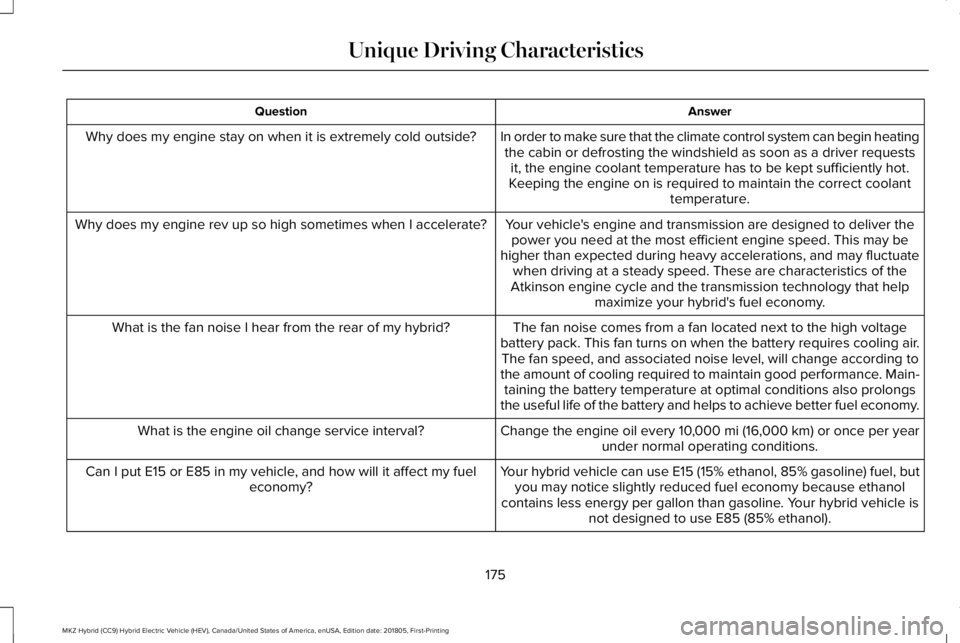
AnswerQuestion
In order to make sure that the climate control system can begin heatingthe cabin or defrosting the windshield as soon as a driver requestsit, the engine coolant temperature has to be kept sufficiently hot.Keeping the engine on is required to maintain the correct coolanttemperature.
Why does my engine stay on when it is extremely cold outside?
Your vehicle's engine and transmission are designed to deliver thepower you need at the most efficient engine speed. This may behigher than expected during heavy accelerations, and may fluctuatewhen driving at a steady speed. These are characteristics of theAtkinson engine cycle and the transmission technology that helpmaximize your hybrid's fuel economy.
Why does my engine rev up so high sometimes when I accelerate?
The fan noise comes from a fan located next to the high voltagebattery pack. This fan turns on when the battery requires cooling air.The fan speed, and associated noise level, will change according tothe amount of cooling required to maintain good performance. Main-taining the battery temperature at optimal conditions also prolongsthe useful life of the battery and helps to achieve better fuel economy.
What is the fan noise I hear from the rear of my hybrid?
Change the engine oil every 10,000 mi (16,000 km) or once per yearunder normal operating conditions.What is the engine oil change service interval?
Your hybrid vehicle can use E15 (15% ethanol, 85% gasoline) fuel, butyou may notice slightly reduced fuel economy because ethanolcontains less energy per gallon than gasoline. Your hybrid vehicle isnot designed to use E85 (85% ethanol).
Can I put E15 or E85 in my vehicle, and how will it affect my fueleconomy?
175
MKZ Hybrid (CC9) Hybrid Electric Vehicle (HEV), Canada/United States of America, enUSA, Edition date: 201805, First-Printing
Unique Driving Characteristics
Page 179 of 575
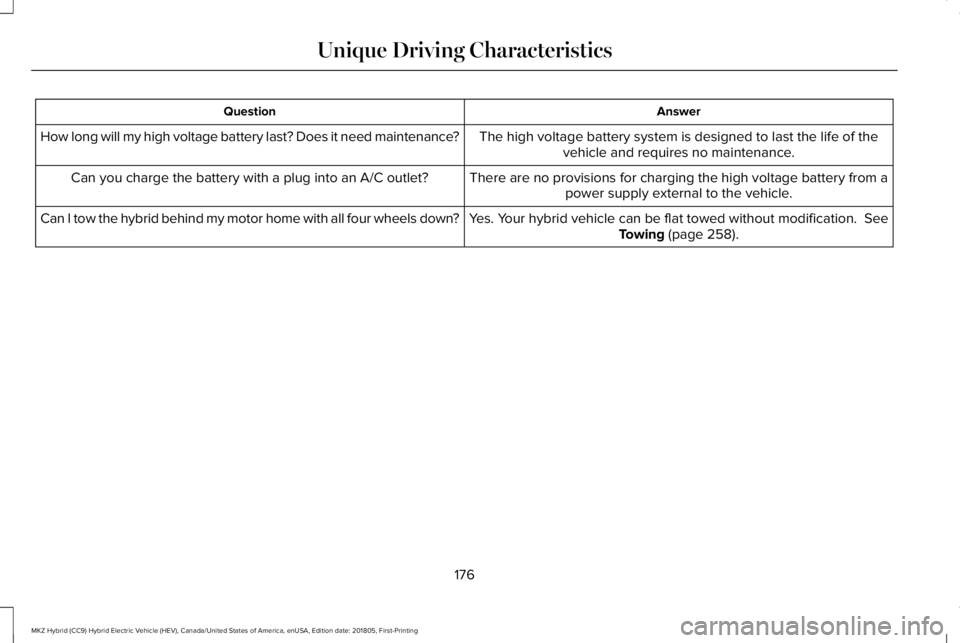
AnswerQuestion
The high voltage battery system is designed to last the life of thevehicle and requires no maintenance.How long will my high voltage battery last? Does it need maintenance?
There are no provisions for charging the high voltage battery from apower supply external to the vehicle.Can you charge the battery with a plug into an A/C outlet?
Yes. Your hybrid vehicle can be flat towed without modification. SeeTowing (page 258).Can I tow the hybrid behind my motor home with all four wheels down?
176
MKZ Hybrid (CC9) Hybrid Electric Vehicle (HEV), Canada/United States of America, enUSA, Edition date: 201805, First-Printing
Unique Driving Characteristics
Page 180 of 575
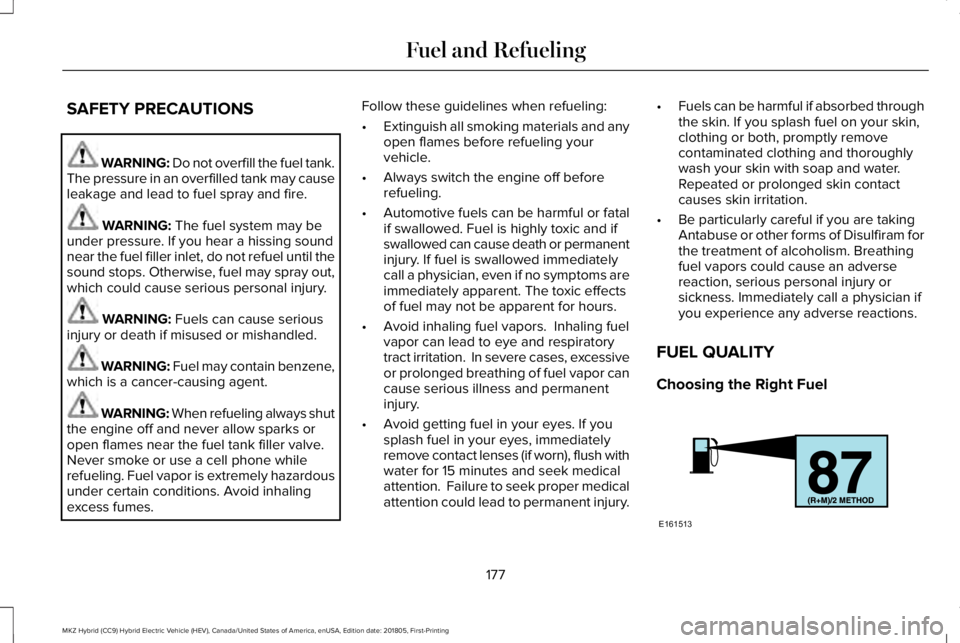
SAFETY PRECAUTIONS
WARNING: Do not overfill the fuel tank.The pressure in an overfilled tank may causeleakage and lead to fuel spray and fire.
WARNING: The fuel system may beunder pressure. If you hear a hissing soundnear the fuel filler inlet, do not refuel until thesound stops. Otherwise, fuel may spray out,which could cause serious personal injury.
WARNING: Fuels can cause seriousinjury or death if misused or mishandled.
WARNING: Fuel may contain benzene,which is a cancer-causing agent.
WARNING: When refueling always shutthe engine off and never allow sparks oropen flames near the fuel tank filler valve.Never smoke or use a cell phone whilerefueling. Fuel vapor is extremely hazardousunder certain conditions. Avoid inhalingexcess fumes.
Follow these guidelines when refueling:
•Extinguish all smoking materials and anyopen flames before refueling yourvehicle.
•Always switch the engine off beforerefueling.
•Automotive fuels can be harmful or fatalif swallowed. Fuel is highly toxic and ifswallowed can cause death or permanentinjury. If fuel is swallowed immediatelycall a physician, even if no symptoms areimmediately apparent. The toxic effectsof fuel may not be apparent for hours.
•Avoid inhaling fuel vapors. Inhaling fuelvapor can lead to eye and respiratorytract irritation. In severe cases, excessiveor prolonged breathing of fuel vapor cancause serious illness and permanentinjury.
•Avoid getting fuel in your eyes. If yousplash fuel in your eyes, immediatelyremove contact lenses (if worn), flush withwater for 15 minutes and seek medicalattention. Failure to seek proper medicalattention could lead to permanent injury.
•Fuels can be harmful if absorbed throughthe skin. If you splash fuel on your skin,clothing or both, promptly removecontaminated clothing and thoroughlywash your skin with soap and water.Repeated or prolonged skin contactcauses skin irritation.
•Be particularly careful if you are takingAntabuse or other forms of Disulfiram forthe treatment of alcoholism. Breathingfuel vapors could cause an adversereaction, serious personal injury orsickness. Immediately call a physician ifyou experience any adverse reactions.
FUEL QUALITY
Choosing the Right Fuel
177
MKZ Hybrid (CC9) Hybrid Electric Vehicle (HEV), Canada/United States of America, enUSA, Edition date: 201805, First-Printing
Fuel and RefuelingE161513